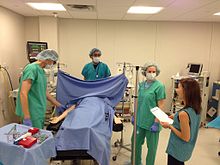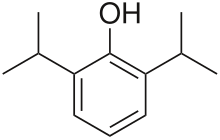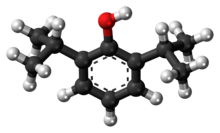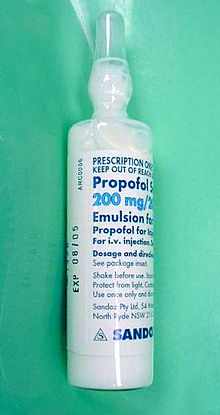| Occupation | |
|---|---|
| Names | Anesthesiologist (US English) Anaesthetist (British English) |
| Profession | |
Activity sectors
| Medicine, science |
| Description | |
Education required
| See selection and training |
Fields of
employment | Science, healthcare, research and development |
Related jobs
| Physician |
An anesthesiologist is a physician [MD/DO] trained in anesthesia and perioperative medicine.
The title of the role varies between countries. In countries following the practice of North America, those specializing in the field are termed anesthesiologists, but in the United Kingdom and current or former member countries of the Commonwealth of Nations, such providers use the title anesthetist instead.
The length and format of training may vary from country to country. For physicians, a four-year residency is required after four years of medical school training to be awarded a medical degree. A four year bachelors degree is required before medical school for a total of 12 years of education. Many anesthesiologists do an additional fellowship year to subspecialize in critical care medicine, cardiac, pediatric, obstetric, or regional anesthesia. Anesthesiologists in training spend this time gaining experience in various different subspecialties of anesthesiology and undertake various advanced postgraduate examinations and skill assessments. These lead to the award of a specialist qualification at the end of their training indicating that they are an expert in the field.
During preoperative evaluation, in consultation with the surgical team, anesthesiologists create an anesthetic plan tailored to each individual patient taking into consideration the patient’s medical history and the type of surgical procedure planned. This may include invasive monitoring (TEE, CVP, arterial pressure), neuraxial nerve blocks (spinal or epidural), peripheral nerve blocks (selectively anesthetizing a specific part of the body), and/or various levels of sedation including reversible unconsciousness known as “General Anesthesia.” Anesthesiologists are acute care specialists and as such provide intensive care techniques perioperatively as the experts of airway management, intraoperative life support, pain control, intraoperative diagnoses, stabilization, and proper postoperative medical management of patients. An anesthesiologist's scope of practice also involves in-hospital and pre-hospital emergencies, work within intensive care units, acute pain units, and chronic pain consultations.
Patient-informed consent
Patient-informed consent is a medical principle stating that patients should be fully informed about the manner in which anesthesia will be administered to them. It is a fundamental ethical and legal principle and is considered essential for the patient autonomy. The American Society of Anesthesiologists and the American Osteopathic Board of Anesthesiology support this principle. In Germany, the law requires that prior to anesthesia, informed consent of the patient must be obtained by the anesthetist.Due to medications given before, during, and after a surgery, a patient may sometimes not remember interactions with the anesthetist, involved in his anesthesia care. The anesthetic plan, as well as alternatives, risks, and benefits of the chosen anesthetic techniques, should be discussed with the patient prior to the surgery. This can be difficult or impossible in some situations, such as with unconscious patients, confused patients, or extremely urgent cases.
Selection and training
Selection and training process is similar in various countries.Argentina
In Argentina, anesthetists are physicians who have specialized in the medical field of anesthesia. A Residency program is 5 years long.Australia and New Zealand
In Australia and New Zealand, anesthetists are medical practitioners (with a university degree such as MB ChB or MB BS) who have undertaken specialist training in the medical field of anesthesia. They are represented by the Australian Society of Anaesthetists and the New Zealand Society of Anaesthetists.Training is supervised by the Australian and New Zealand College of Anaesthetists. The ANZCA-approved training course encompasses an initial two-year long Pre-vocational Medical Education and Training (PMET) and three years of advanced training. Thus the total training is 5 years long. In the course, trainees are required to successfully complete five years of supervised clinical training at approved training sites and pass both the primary and final examinations which consist of both written (multiple choice questions and short-answer questions) and, if successful in the written exams, oral examinations (viva voce).
In the final written examination, there are many questions of clinical scenarios (including interpretation of radiological exams, EKGs and other special investigations). There are also two cases of real patients with complex medical conditions - for clinical examination and the following discussion. The course has a program of 12 modules such as obstetric anesthesia, pediatric anesthesia, cardiothoracic and vascular anesthesia, neurosurgical anesthesia and pain management. Trainees also have to complete an advanced project, such as a research publication or paper. They also undergo an EMAC (Effective Management of Anaesthetic Crises) or EMST (Early Management of Severe Trauma) course. On completion of training, the trainees are awarded the Diploma of Fellowship and are entitled to use the qualification of FANZCA – Fellow of the Australian and New Zealand College of Anaesthetists.
Brazil
In Brazil, the anesthetists are physicians who have specialized in the field of anesthesia. Approximately 650 physicians are admitted yearly to a three-year specialization program. The residency programs can take place at training centres in university hospitals. These training centres are accredited by the Brazilian Society of Anaesthesiology (SBA), or other referral hospitals accredited by the ministry of health. Most of the residents are trained in different areas, including ICU, pain management, and anesthesia sub-specialties, including transplants and pediatrics. In order to be a certified anesthetist in Brazil, the residents must give exams throughout the residency program and at the end of the program. The SBA conducts these examinations. In order to be an instructor of a residency program certified by the SBA, the anesthetists must have the superior title in anesthesia, in which the specialist undergoes a multiple choice test followed by an oral examination conducted by a board assigned by the national society.Canada
In Canada, anesthesiologists are physicians (with the degree MD - Medicinae Doctorem or DO - Doctor of Osteopathic Medicine, or MDCM - Medicinae Doctorem et Chirurgiae Magistrum) who have specialized in the medical field of anesthesiology. Training is supervised by 17 universities approved by the Royal College of Physicians and Surgeons of Canada.[1] Upon completion of a residency program (typically five year long), the candidate is required to pass a comprehensive objective examination consisting of a written component (two three-hour papers: one featuring 'multiple choice' questions, and the other featuring 'short-answer' questions) and an oral component (a two-hour session relating to topics on the clinical aspects of Anesthesiology). The examination of a patient is not required. Upon completion of training, the anesthesia graduate is then entitled to become a "Fellow of the Royal College of Physicians of Canada" and to use the post-nominal letters "FRCPC".Canadian family physicians with one year of anesthesia training may also provide anesthetic services, but this is typically limited to smaller rural and remote hospitals. These physicians are often referred to as "GP anesthetists" or GPAs; alternatively they may be referred to as having a "2+1 in anesthesia" given their two years of family medicine residency and one year of anesthesia training. Technically, it would be incorrect to call a GPA an "anesthesiologist" as this term is exclusive to those having completed a five year anesthesiology residency, whereas the term "anesthetist" applies to anyone administering anesthesia to a patient.
Germany
In Germany, anesthetists (German: Anästhesist or Facharzt für Anästhesiologie) are the only anesthesia providers as German law does not allow anyone but a physician (doctor) to practice medicine. It is called a "physician-centred medicine" (German: Arztvorbehalt).After earning the right to practice medicine (German: Approbation),[2] German physicians who want to become anesthetists must undergo 5 years of training, consisting of anesthesia, ECG and pulmonary function testing, critical care and pain medicine, and also palliative care medicine. The training includes rotations serving in the operation theatres to perform anaesthesia on a variety of patients being treated by various surgical sub-specialties (e.g. general surgery, neurosurgery, invasive urological and gynecological procedures), followed by a rotation through various intensive-care units.[3] Many German anaesthetists choose to complete a curriculum in emergency medicine, which once completed, enables them to be referred to as Notarzt, an emergency physician working pre-clinically with the emergency medical service. In pre-clinical settings the emergency physician is assisted by paramedics.[4]
Netherlands
In the Netherlands, anesthetists are physicians who have specialized in the medical field of anesthesia. Anesthetists in the Netherlands must complete medical school training, which takes six years. After successfully completing medical school training, they start a five-year residency training in anesthesia. In their fifth year, they can choose to spend the year doing research or to specialize in a certain area, including regular anesthesia, critical care medicine, pain and palliative medicine, pediatric anesthesia, cardiothoracic anesthesia, neuro-anaesthesia or obstetric anesthesia.Guatemala
In Guatemala, anesthetists are physicians who have specialized in the medical field of anesthesia. For this, a student with a medical degree (he or she must have surgery and general medicine skills by law) has to complete a residency of six years (five years in residency and one year of practice with an expert anesthetist).After residency, students take a board examination conducted by the college of medicine of Guatemala, the Universidade De San Carlos De Guatemala (Medicine Faculty Examination Board), and a chief physician who represents the health care ministry of the government of Guatemala. The examination includes a written section, an oral section, and a special examination of skills and knowledge relating to anesthetic instruments, emergency treatment, pre-operative care, post-operative care, intensive care units, and pain medicine. After passing the examination, the college of medicine of Guatemala, Universidad De San Carlos De Guatemala and the health care ministry of the government of Guatemala grants the candidate a special license to practice anaesthesia as well as a diploma issued by the Universidad De San Carlos De Guatemala granting the degree of physician with specialization in anaesthesia. Anesthetists in Guatemala are also subject to yearly examinations and mandatory participation in yearly seminars on the latest developments in anesthetic practice.
Hong Kong
In Hong Kong, anesthesiologists are physicians who have specialized in the medical field of anesthesiology. To be qualified as an anesthesiologist in Hong Kong, medical practitioners must undergo a minimum of six years of postgraduate training and pass three professional examinations. Upon completion of training, the Fellowship of Hong Kong College of Anesthesiologists and subsequently the Fellowship of Hong Kong Academy of Medicine is awarded. Practicing anesthesiologists are required to register in the Specialist register of the Medical Council of Hong Kong and hence are under the regulation of the Medical Council. [5]Italy
In Italy, the term anesthesiologist-intensive care doctor refers to a physician who, after completion of 6.5 years of medical school training, has completed an accredited four (five since 2008) year residency in anesthesiology. Such doctors work in operation theatres, ICUs, PACUs, Pain control units, Hyperbaric units, Emergency rooms, etc.The Nordic Countries
In Denmark, Finland, Iceland, Norway, and Sweden, anesthesiologists' training is supervised by the respective national societies of anesthesiology as well as the Scandinavian Society of Anesthesiology and Intensive Care Medicine (SSAI). In the Nordic countries, anesthesiology is the medical specialty that is engaged in the fields of anesthesia, intensive care medicine, pain control medicine, pre-hospital and in-hospital emergency medicine. Anesthesiologist in the Nordics is a doctor who has completed a six-year undergraduate training program (from medical school), a twelve-month internship, and a five-year residency program. SSAI currently hosts five training programs for anesthesiologists in the Nordics. These are Intensive care, Pediatric anesthesiology and intensive care, Advanced pain medicine, Critical care medicine, and Advanced obstetric anesthesiology.United Kingdom
In England, Northern Ireland, Scotland, and Wales, training is supervised by the Royal College of Anaesthetists. Anesthetists in the United Kingdom are physicians who have completed either a five-year or six-year undergraduate medical school training program or a four-year medical school program open only for postgraduates.Following the completion of medical school training, physicians enter a two-year foundation program which consists of at least six, four-month rotations in various medical specialties. It is mandatory for all physicians to complete a minimum of three months of general medicine and general surgery training during this time. Following the foundation program, physicians compete for specialist training. The training program in the United Kingdom currently consists of two years of core training and five years of higher training. Also, before the end of core training, all trainees must have passed the primary examination for the diploma of Fellowship of the Royal College of Anaesthetists (FRCA).
Trainees wishing to hold dual accreditation in anesthesia and intensive care medicine may enter anesthesia training via the Acute Care Common Stem (ACCS) program which lasts three years and consists of experience in anesthesia, emergency medicine, acute medicine and intensive care. Trainees in anesthesia are called Specialty Registrars (StR) or Specialist Registrars (SpR). The Certificate of Completion of Training(CCT) in anesthesia is divided into three levels: Basic, intermediate and advanced. During this time, physicians learn anesthesia as applicable to all surgical specialties. The curriculum focuses on a modular format, with trainees primarily working in one special area during one module, for example, cardiac anesthesia, neuro-anaesthesia, ENT, maxillofacial, pain medicine, intensive care, and trauma. Traditionally (before the advent of the foundation program), trainees entered anesthesia from other specialties, such as medicine or accidents and emergencies. Specialist training takes at least seven years. On completion of specialist training, physicians are awarded CCT and are eligible for entry on the GMC Specialist register and are also able to work as consultant anesthetist. A new consultant in anesthetics must have completed a minimum of 14 years of training (including five to six years of medical school training, two years of foundation training, and seven years of anesthesia training).
Those wishing for dual accreditation (in Intensive care and anesthesia) are required to undergo an additional year of training and also complete the Diploma in Intensive Care Medicine (DICM). Pain specialists give the Fellowship of the Faculty of Pain Medicine of the Royal College of Anaesthetists (FFPMRCA) examination.
United States
Photo of prebriefing for mixed modality simulation being used for anesthesia resident training
In the United States, anesthesiologists are physicians (MD or DO) who have chosen to specialize in anesthesiology and are extensively trained. Anesthesiologists in the United States must have completed a four-year undergraduate college program (that includes pre-medical requirements) and four years of medical school training. Anesthesiology residency programs in the United States require successful completion of four years of residency training at an approved program for board certification eligibility in the specialty of anesthesiology.[6] Anesthesiology residents face multiple examinations during their residency, including exams encompassing physiology, pathophysiology, pharmacology, and other medical sciences addressed in medical school, along with multiple anesthesia knowledge tests which assess progress during residency. Successful completion of a written and oral board exam after completion of residency is required for board certification.
Anesthesiology residency training in the U.S. encompasses the full scope of perioperative medicine, including pre-operative medical evaluation, management of pre-existing disease in the surgical patient, intraoperative life support, intraoperative pain control, post-operative recovery, intensive care medicine, and chronic and acute pain management. After residency, many anesthesiologists complete an additional fellowship year of sub-specialty training in areas such as pain management, sleep medicine, cardiothoracic anesthesiology, pediatric anesthesiology, neuroanesthesiology, regional anesthesiology/ambulatory anesthesiology, obstetric anesthesiology, or critical care medicine.[7]
The average salary for a full-time anesthesiologists is roughly $470,000 according to US News.[8] The number of jobs are rounding to about 170,400 according to statistics in 2014.[9]
The majority of anesthesiologists in the United States are board-certified, either by the American Board of Anesthesiology (ABA) or the American Osteopathic Board of Anesthesiology (AOBA). D.O. anesthesiologists can be certified by the ABA. The ABA is a member of the American Board of Medical Specialties, while the AOBA falls under the American Osteopathic Association. Both Boards are recognized by the major insurance underwriters in the U.S. as well as by all branches of the U.S. Uniformed Services. Board certification by the ABA involves both a written and an oral examination. AOBA certification requires the same exams, in addition to a practical examination with examining physicians observing the applicant actually administering anesthetics in the operating room.



